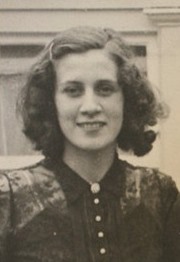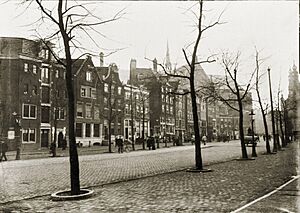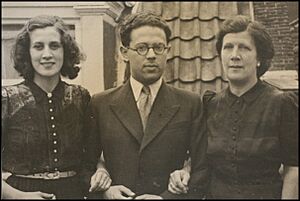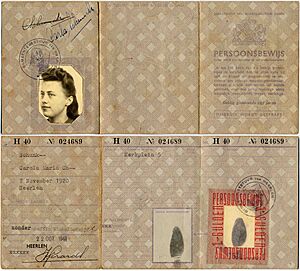Tina Strobos facts for kids
Quick facts for kids
Tina Strobos
|
|
|---|---|

Strobos in 1941
|
|
| Born |
Tineke Buchter
May 19, 1920 Amsterdam, Netherlands
|
| Died | February 27, 2012 (aged 91) Rye, New York, US
|
| Alma mater | University of Amsterdam |
| Occupation | Psychiatrist |
| Known for | Rescuing over 100 Jewish Holocaust refugees during World War II |
| Spouse(s) |
|
| Children | 3 children and 2 stepchildren |
| Parent(s) | Marie Schotte and Alphonse Buchter |
| Awards | Elizabeth Blackwell Medal |
| Honors | Righteous Among the Nations |
Tina Strobos (born Tineke Buchter; May 19, 1920 – February 27, 2012) was a brave Dutch doctor and psychiatrist from Amsterdam. She is famous for her amazing work helping people during World War II.
While she was a young medical student, Tina worked with her mother and grandmother. They rescued over 100 Jewish refugees. This was part of the Dutch resistance during the Nazi occupation of the Netherlands. Tina used her house as a hiding place for Jews. It had a secret attic room and a special bell system to warn people about police raids. Tina also smuggled guns and radios for the resistance. She even made fake passports to help refugees escape the country. The Gestapo (German secret police) arrested and questioned her nine times. But she never told them where anyone was hiding.
After the war, Tina finished her medical degree. She became a psychiatrist and studied with Anna Freud in England. Later, Tina moved to the United States. She continued her studies there with a Fulbright scholarship. She settled in New York, got married twice, and had three children. Tina became a family psychiatrist. In 1998, she received the Elizabeth Blackwell Medal for her medical work. She retired in 2009.
In 1989, Tina was honored as Righteous Among the Nations by Yad Vashem. This award is for non-Jewish people who risked their lives to save Jews during the Holocaust. In 2009, she was also recognized by the Holocaust and Human Rights Education Center in New York City.
Contents
Tina's Early Life
Tina Strobos was born Tineke Buchter on May 19, 1920, in Amsterdam. Her parents, Marie Schotte and Alphonse Buchter, were socialist and atheist. They spoke four languages. Tina's mother, Marie, supported the women's peace movement. Her grandfather started a freethinking group. Her grandmother was part of the labor movement in the late 1800s. Tina's family had a history of helping people in need. Her parents had taken in refugees from earlier wars. Her grandmother had helped Belgian refugees during World War I.
When Tina was ten, her parents divorced. She lived with her mother. By age sixteen, Tina knew she wanted to be a psychiatrist. She started studying medicine at university. But her studies stopped when Germany invaded the Netherlands in 1940.
Helping Others During World War II
When the Germans invaded the Netherlands in May 1940, Tina was almost twenty. She lived with her mother and their maid in Amsterdam. University students were told to sign a promise of loyalty to Adolf Hitler. But Tina and her classmates refused. The medical school then closed. Tina and many other students joined the underground movement.
A Safe House and Secret Hiding Place
Tina started her rescue work by hiding her best friend, a Jewish girl named Tirtsah Van Amerongen. A family friend, Henri Polak, also needed a hiding place. Tina's grandmother agreed to help him.
Throughout the war, Tina worked with her mother and grandmother. They rescued over 100 Jewish refugees. They hid four or five people at a time in their boarding house at 282 Nieuwezijds Voorburgwal. The house used to be a city school and had three floors. After Tina and her mother started hiding people, a carpenter from the Dutch underground built a small hiding place. It was in the attic, inside a gable. The Gestapo raided the house eight times, but they never found this secret spot.
Tina and her mother had a warning bell system. They used it to tell refugees on the upper floors about unexpected Gestapo visits. If there was no time to hide, people could escape through a window to the next building. An unknown person at Gestapo headquarters sometimes called to warn them of raids. They never found out who this helper was.
Some Jews stayed for a long time, but mostly, Tina's house was a temporary safe place. People stayed for a short time until they could move to a safer spot. Some refugees were smuggled to Spain, Switzerland, or the Dutch countryside. Tina and her mother often visited the people they had helped hide. They cycled many miles to bring news and conversation to those in isolated places. One person Tina helped was the painter Martin Monnickendam. He painted her portrait and gave it to her. She kept it for many years.
Tina's house was only a ten-minute walk from Anne Frank's hiding place. Tina never met the Frank family. She later wished the Franks had an escape route. She said, "If I knew they were there, I would have gotten them out of the country."
Facing the Gestapo
During the war, Tina was arrested and questioned by the Gestapo nine times. They grabbed her wrists and threw her against a wall. Once, she was knocked unconscious. But she never told them where any Jews were hiding. Tina learned ways to get through these interrogations safely. Even though she spoke German perfectly, she always asked for an interpreter. This gave her extra time to calm down and think. Once, a Nazi officer commented on her legs. Tina felt stronger. She realized he was just a man. This gave her confidence. She could say "I didn't know he was a Jew" in a stronger, more believable way.
Helping Abraham Pais
In the early war years, Tina was engaged to Abraham "Bram" Pais. He was a young Jewish physicist. Tina and her mother found hiding places for Bram and many of his relatives. They ended their engagement in 1943, but they stayed friends.
In February 1945, Bram was hiding with three Jewish friends. One of Bram's old girlfriends betrayed them. All four were arrested. When Tina heard, she found the Gestapo officer in charge. She convinced him to let two of the friends go free. But she could not save the third. Rescuing Bram needed a bigger plan. Tina had a letter from the famous physicist Niels Bohr. Bohr had invited Bram to study with him in Denmark. Tina took this letter to a high-ranking German official. She asked him to free Bram. She called him "a young genius in physics" who would do great things. After some phone calls, the official ordered Bram to be released. Bram later became a well-known nuclear physicist. He wrote life stories of Niels Bohr and Albert Einstein.
Other Resistance Activities
Tina and her mother also hid important members of the Dutch underground. This included resistance leader Johan Brouwer. His group did dangerous work like smuggling weapons and building bombs. At first, Tina smuggled weapons, radios, and explosives. She traveled up to fifty miles with these items hidden in her bicycle basket. She brought news and ration stamps to Jews hiding on farms. She also brought radios and guns for the Dutch resistance. Sometimes, Tina hid large boxes of guns in her house. As the resistance became more violent, Tina focused more on helping Jews escape. She also worked with another group to shelter refugees and make fake passports.
To make fake papers, Tina stole identity cards from non-Jewish people at parties. She replaced the photos and fingerprints with those of her Jewish refugees. Sometimes, she found other ways to get papers. She asked pickpockets to steal identity cards from travelers at train stations. In 1941, she even stole passports from coat pockets at her aunt's funeral.
Tina's grandmother, Marie Schotte Abrahams, had a hidden radio transmitter. It was used to send secret messages from the Dutch underground to the BBC in Britain. She kept this radio even though Germans said hiding radio equipment meant a death penalty. Once, a Nazi visited her house and tried to question her. She grabbed his arm, looked him in the eye, and asked, "Did I not see you stealing a Persian rug from the Mendlessohns' apartment next door a few nights ago?" The Nazi officer quickly left. Tina later said her grandmother was "the only person I know who scared the Gestapo."
Even with universities closed, Tina kept studying medicine during the war. She sometimes let her house be a meeting place for secret medical classes. Up to eighteen students met there every week. The local hospital allowed small groups to study pathology. In May 1945, she was taking her pharmacology exam at her professor's house. The Canadian Army arrived to free the Netherlands. Everyone rushed outside to watch the tanks and soldiers come through the city.
Life After the War and Awards
After the war, Tina earned her medical degree from the University of Amsterdam in 1946. She then studied psychiatry in London, England, with Anna Freud. In the 1950s, Tina went to Valhalla, New York. She did a residency in psychiatry and neurology at Westchester Medical Center. She studied child psychiatry with a Fulbright scholarship.
Tina became a family psychiatrist. She focused on helping people with mental challenges. In 1998, she received the Elizabeth Blackwell Medal for her work as a doctor. She retired from her practice in 2009.
In 1989, Tina and her mother, Marie Schotte, were officially named Righteous Among the Nations by Yad Vashem. In 2009, Tina was honored for her rescue work by the Holocaust and Human Rights Education Center in New York City. When asked why she risked her life, Tina said, "It's the right thing to do... Your conscience tells you to do it. I believe in heroism, and when you're young, you want to do dangerous things."
Family Life
Tina's first husband was Robert Strobos, a neurologist. In 1947, they traveled to the West Indies. Tina worked there as a psychiatrist for two years. After divorcing Robert in 1964, Tina Strobos married economist Walter Chudson in 1967. Walter was an American Jew who worked for the United Nations. Tina and Walter settled in Larchmont, New York. They stayed together until he passed away in 2002.
Tina had two sons and one daughter from her first marriage. She also had two stepchildren from her second marriage. Her two sons became a doctor and a paramedic. Her daughter became a psychoanalyst. When Tina passed away, she had seven grandchildren and two step-grandchildren.
Death
Tina Strobos died from cancer at age 91. She passed away on February 27, 2012, in Rye, New York.




